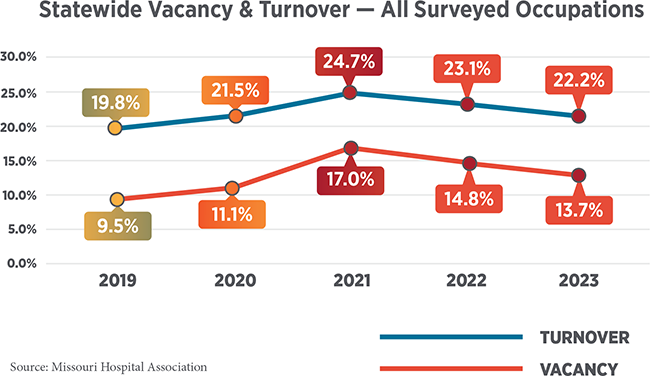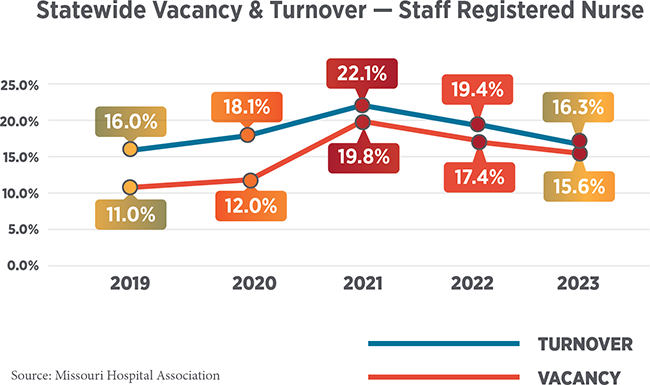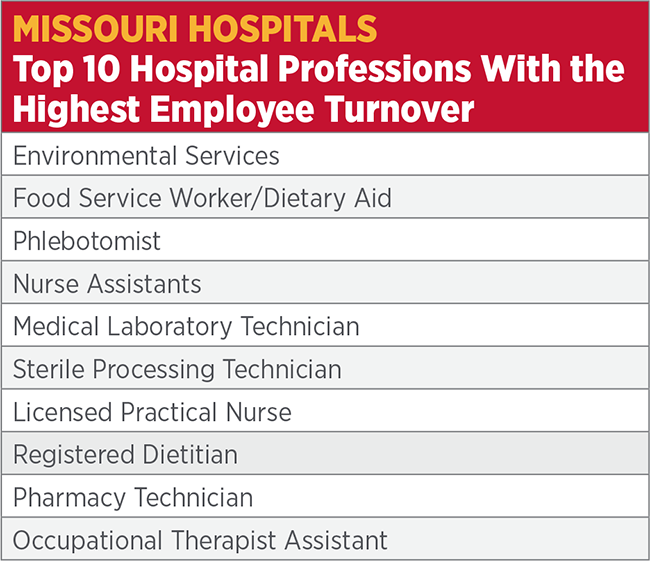Expert

Dave Dillon
Actions
Type
Topic
- Economic Impact
- Workforce
Tags
JEFFERSON CITY, Mo. — Vacancy and turnover rates among registered nurses, and within the hospital workforce overall, eased slightly in 2023 according to new data from the Missouri Hospital Association. Although declining rates of vacancy and turnover are a positive sign, Jon D. Doolittle, MHA President and CEO said, the rates remain higher than before the pandemic, which caused significant disruption in the workforce.
MHA’s workforce data collection focuses primarily on the influence of two components — vacancies and turnover. The inability to find qualified staff to fill open positions causes vacancies. When a staff member leaves and is replaced, this results in turnover. Doolittle said both challenges can influence hospital operations and organizational culture and are why Missouri’s hospitals and their partners are focused on recruiting, training and retaining the health care workforce.

“Missourians’ health requires hospitals that thrive at managing operations, treating patients and serving their communities,” Doolittle said. “This data affirms that hospital jobs are in demand in the current market, and that people attracted to health care jobs can find opportunity for growth and satisfaction improving their neighbors’ health.”
Staff Registered Nurses (R.N.s) are the largest single category of hospital employees, with a total worker pool of approximately 44,500 individuals. Throughout the state, nearly 7,000 R.N. positions are vacant for lack of qualified applicants — 15.6% of all positions. Nurse turnover remains high as well, with nearly 7,250 nurses, or 16.3%, leaving their hospital during 2023.

“Troubling rates of vacancy and turnover persist in a variety of roles essential to care delivery — including the R.N.s and the staff that support bedside care,” Doolittle said. “At the same time, positions that are essential to hospital operations, including food service workers and environmental services, have turnover rates that exceed 50% statewide. To compete in the job market, hospitals continue to innovate and evolve to be employers of choice.”
 |
 |
Several other surveyed worker categories support R.N.s in providing care. MHA surveys hospitals for vacancy and turnover of Licensed Practical Nurses and Nurse Assistants — the latter of which includes Patient Care Technicians, Certified Nurse Assistants and unlicensed assistive personnel. The vacancy rates on these workers are similar or higher than R.N.s, but the turnover rate is significantly higher —nearly 37% for Nurse Assistants. Vacancy and turnover rates in these positions increase the pressure on the R.N. workforce.
“To serve patients and provide high-quality care, hospitals require a team of workers acting in concert,” Doolittle said. “Turnover and vacancies in imaging, lab services, therapy or pharmacy, for example, influence a hospital’s ability to provide the care Missourians need and deserve.”
Geography can influence the pool of available workers of all kinds. In 2023, regional variation was evident in Staff R.N. data, with turnover especially pronounced in rural parts of the state. For example, in Missouri’s South-Central region, the turnover rate of R.N.s was twice the state average at 35.2%.
Regional data are available here.
In the St. Louis region, hospitals experienced a turnover rate of approximately 75% in environmental services and food service workers/dietary aids. Vacancy rates in both categories are low, which implies success filling these positions after separations. However, efforts to train and onboard these workers are time-consuming and costly.
“Hospital leaders consistently list the workforce as a top immediate and long-term priority,” Doolittle said. “The Missouri Hospital Association is their partner in developing successful workforce initiatives for today and diversified pipelines to educate and train the health care workforce going forward.”
The report includes statewide and regional data from 128 hospitals and vacancy and turnover rates for 33 hospital- and clinic-based positions. A comprehensive collection of workforce data, trends, and color-coded vacancy and turnover maps are available at MHAnet.com.
# # #
The Missouri Hospital Association is a not-for-profit association in Jefferson City that represents 139 Missouri hospitals. In addition to representation and advocacy on behalf of its membership, the association offers continuing education programs on current health care topics and seeks to educate the public about health care issues.









